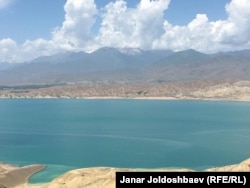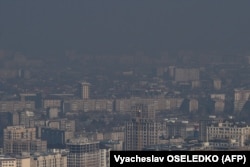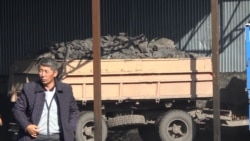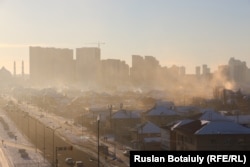
With temperatures dropping below freezing in Kyrgyzstan and Uzbekistan and snow appearing in northern Kazakhstan, officials are turning to coal as the answer to meet people's heating and electricity needs this winter.
Kyrgyzstan
The warning signs of energy problems this coming winter appeared in the spring and summer in Kyrgyzstan.
Most of Kyrgyzstan's domestically generated electricity comes from hydropower and because of a severe drought this year, some are predicting the biggest energy crisis in years.
National Energy Holding Company chief Talaybek Baygziev announced at the end of September that there would be "restrictions on the lighting of secondary streets, advertisements, and the facades of shops, cafes, and other nonresidential customers" in cities and towns around the country.
But those cuts won't be enough to keep homes and businesses well-lit and heated for the next several months.
The Toktogul hydropower plant (HPP) -- which supplies some 40 percent of Kyrgyzstan's electricity -- currently has a water level in its reservoir of some 12.5 billion cubic meters (bcm).
One year ago, the level was 15.2 bcm and the desirable level by winter's end to ensure the HPP's smooth operation is 16 to 17 bcm of water.
The deputy chairman of Kyrgyzstan's cabinet of ministers, Aziz Aaliev, said that in normal years during the autumn-winter period "some 6 to 7 bcm is released" from the reservoir to power the turbines at the Toktogul HPP to generate the electricity needed.
But with only 12.5 bcm currently in the reservoir, he said "there is a risk of a shutdown in April" if the water level reaches the "dead zone," when the level of water is lower than the turbines, rendering the HPP powerless.
The dead zone is 5.5 bcm of water and is the minimum amount needed for the HPP to operate.
Kyrgyz officials are therefore facing the choice of reducing the amount of water released this winter to maintain the necessary levels for the spring and summer -- when the water is needed for agricultural purposes in downstream countries Uzbekistan and Kazakhstan -- or to use the water as usual this autumn and winter with the understanding that less water might be available during the growing season next year and risking a shutdown of the Toktogul HPP.
The latter alternative would certainly upset Uzbekistan and Kazakhstan, both of which are fulfilling earlier promises to export electricity to Kyrgyzstan specifically to allow the Toktogul reservoir to accumulate the needed amount of water for crops next year.
Kyrgyz authorities plan to increase the cost of electricity starting next year, a necessary move but one that is likely to be unpopular among consumers.
President Sadyr Japarov wrote on Facebook that Uzbekistan and Kazakhstan use water from the Toktogul reservoir for irrigation, "and Kyrgyzstan only to generate electricity." He added that people in Kyrgyzstan "are not concerned about [the amount of electricity they use] because it is cheap."
Japarov said the price of imported electricity from neighboring countries is higher than what Kyrgyzstan's consumers pay to the government, which obviously creates difficulties for the state coffers. Japarov said that, by raising prices, "God willing, we can overcome the energy shortage by 2024-2025 and start exporting it."
In the meantime, since Kyrgyzstan does not have significant deposits of oil or natural gas, people must go back to a more traditional and primitive source of energy to heat their homes and generate electricity this winter: coal.
And coal prices are increasing worldwide, including in Central Asia.
The Bishkek thermal power plant (TPP) was recently repaired and upgraded, but when it resumed operations in late 2017 it was only a few months until an accident knocked it out of commission during the coldest days of the winter in late January 2018.
Corruption was to blame as officials scammed up to $100 million off the $384 million China provided to renovate the Bishkek TPP.
The Kyrgyz capital will depend on its TPP and officials are already bringing coal to Bishkek to keep the plant running this winter.
Worries about ensuring coal supplies are already such that at the Kara-Keche mine in Naryn Province -- one of Kyrgyzstan's largest coal mines -- local company Kyrgyzkomur installed video surveillance and the State National Security Committee sent members of the country's elite Alfa special forces unit to guard it.
For those looking to keep their homes warm in Kyrgyzstan, the prices for coal are already rising and that has caused a lot of grumbling and blaming.
In winter 2020-2021, the price of one ton of coal in Bishkek was 3,600 to 3,800 soms (about $42 to $45) per ton, but this year the price has jumped to around 5,000 soms, nearly $60 in a city where the average salary is about $220.
Parliament deputy Tazabek Ikramov said the price for a ton of coal in the northeastern city of Karakol is 6,000 soms and, in the southern Batken Province, it was 7,500 soms.
Kazakhstan
Kazakhstan is not talking about an energy shortage yet, but the media has reported coal shipments being made to the capital, Nur-Sultan.
State agency Kazinform reported on October 8 that 171 train wagons of coal were loaded for Nur-Sultan in the first seven days of October.
Kazakhstan has the 10th largest coal reserves in the world, so the problem is not supply but rather why Kazakhstan is still dependent on coal for more than half the energy it generates.
Efforts are under way to gasify Nur-Sultan and that project should be completed by 2023.
But ironically, when Nur-Sultan hosted EXPO-2017 (it was then called Astana), the theme was future energy and it was intended to showcase renewable sources. Yet more than four years later one of the oldest and dirtiest sources of energy is being used as a guarantee for the country's heat and electricity needs for the coming winter.
And for the cities, towns, and villages burning extra coal this winter, it will add to the growing air-pollution problem across the eastern half of Central Asia.
Bishkek already has some of the most polluted air of any big city in the world, while the Kazakh city of Almaty has long had a reputation for having a serious air-pollution problem.
Even Nur-Sultan, which despite being located on a windy steppe, has also seen increasingly blacker skies in recent winters from all the TPPs in use.
Uzbekistan
With estimated reserves of nearly 1 trillion cubic meters of natural gas, Uzbekistan should have no problem providing this fuel to its citizens.
But the winter of 2020-2021 saw many communities temporarily cut off from gas supplies, including neighborhoods in the capital, Tashkent.
People in several cities protested against the suspension of supplies and, in mid-December, Uzbek President Shavkat Mirziyoev ordered a halt to all gas exports, which had brought in more than $2 billion annually.
Back in January 2018, Mirziyoev called for boosting gas production from some 57 bcm to some 63 bcm annually, but in 2020 gas production fell by 18.1 percent and totaled only some 47.1 bcm, according to the 2021 BP Statistical Review of World Energy.
In an effort to head off gas problems this winter, Uzbek authorities dropped tariffs on imported gas and signed a new deal with neighboring Turkmenistan to buy more gas.
Last winter, the only remedy officials could offer during electricity and gas cutoffs was to make more gas cannisters, firewood, and coal available.
Coal production in all Central Asian countries -- except for Turkmenistan -- has been increasing steadily for years.
The Central Asian countries are marking 30 years of independence this year and during that period they have spent their own money and received massive loans and grants from international organizations to improve and modernize their domestic power-producing capacities.
But as winter 2021 approaches, the main source of energy for heating and electricity continues to be coal. And in many cases, even the use of the dirty fossil fuel will not be enough to provide everyone in Central Asia with the heat and power they need.













